Boston Crossfit Certification Seminar: Day One
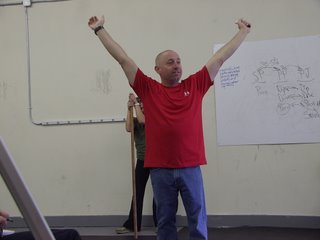
“We teach people what their ass does for a living.”—Greg Glassman
Walking into the first day of a Crossfit Certification is like walking onto a Hollywood set. You recognize everyone, and no one recognizes you.
The hallucinogenic qualities of the experience are heightened by the familiarity of the terrain. This is the building I train in every day. At least, I think it’s this building.
The equipment had disappeared, and a bunch of Crossfit Rockstars stood in its place. Greg Amundson, Nicole Carroll, Coach. Kelly Moore, Jesse Woody, Lynne Pitts, and Carrie Klumpar.
I felt like a pre-teen girl at an N’Sync concert, except the stage-front security was nowhere to be seen. Disneyland for fitness freaks. A backstage pass to GPP Lollapalooza.
It was on.
Sam and I were ridiculously early, towing our new friends from Crossfit Cape Fear—John, Shad, and Heidi. We signed the “Yep, you’re probably going to die” waiver, and proceeded to hug everyone in the building. I zeroed in on Lynne. I’d failed to convince her that the gangsters in Roxbury are asleep at 7:00 a.m., and I was anxious to hear the horror stories of her journey from New Hampshire.
She didn’t have any, but she did have a new piece of equipment coming her way. I grabbed an AF Bar from the corner, and presented it with all the decorum of a guard at Westminster Abbey. It had the intended effect—jealousy. I think Kelly wanted one before she found out what it was.

Standing with two Crossfit legends, I bellowed across the room at my girlfriend, gesturing for her to come say hello. Sammy came over, smiling like it was going out of style.
Between the two of them, Lynne and Kelly beat the hell out of nearly every fitness pursuit worth pursuing—Crossfit, RKC, Clubbells, powerlifting, gymnastics—and Sam knows it. Standing face-to-face with her role models, Sam exhibited all the humility and grace you’d expect from a novice. Not surprisingly, those traits were returned in spades by our new friends. The lack of ego was palpable.
The joy on Sam’s face was worth the price of admission, and we hadn’t even started yet. At 8:00, Nicole stood under the whiteboard, calling for attention.
She introduced Coach Glassman to thunderous applause. Greg Glassman created Crossfit during decades of work as a trainer, embracing a contrarian approach to fitness that often left him on the wrong side of the popularity divide. He commands attention in a manner that belies his stature—at five foot six or so, his physical presence is unintimidating. Nonetheless, his eloquence draws you in and keeps you there.
We started at the beginning. The Tao of Crossfit. In tiny blue letters, Coach marked up the corner of the board:
“Empirically Driven Continuously Tested Community Developed Constantly Varied Functional Movement High Intensity.”
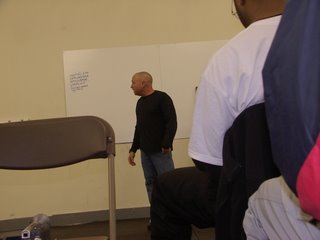
Everything you need to know about Crossfit in twelve words. He left his scribble to soak in, and launched into the basic movements of our trade.
The squat. According to Coach, it takes three to five years to develop a mature squat—torso upright, lumbar arch maintained, midline stabilization constant.
Using his demonstration piece, a sarcastically self-professed “dumb jock”, we got an up-close view of athletic perfection. Nicole made the squat look easy, cranking out rep after rep with flawless form. The downward portion of the movement is initiated by the hip flexors—rather than fall into the bottom position, the athlete pulls back and down. The return to standing is accomplished using a full contraction of the butt and hamstrings, and the weight remains on the heels for the duration. Her lower lumbar arch is enduring.

It’s amazing how hard this is to do correctly.
Coach pointed out the alignment of the pelvis and spine, using a simplified schematic that we’d see ad nauseum over the next two days—a stylized “s” connected at the tail with an oval. For a first-hand look at this artistic masterpiece and a great overview of basic anatomy and physiology, grab a copy of the August 2003 Crossfit Journal.
The point of the drawing: in nearly every athletic movement, the pelvis remains wedded to the spine, forming a continuous line unperturbed by posterior tilt.
“In this position, she’s bombproof. She’s bulletproof…your ability to punch, jump, run, throw…will be largely determined by your ability to maintain stabilization of this structure…Extension of the hip is necessary and maybe even sufficient for elite athleticism. If you cannot powerfully, explosively extend the hip while maintaining midline stabilization, you are working at a fraction of your capacity.”

This little bit of information would remain with me all weekend long, rearing its head again and again as I practiced squats, wall ball, high pulls, and slam ball. Evidently, my spinal alignment leaves something to be desired.
Using a five-foot dowel, Nicole demonstrated proper deadlifting technique. The shoulders remain behind the hands, arms taut, lumbar arch maintained. The load stays in the frontal plane throughout the movement, following a vertical path from the ground to lockout.
To allow for a straight up and down movement, the knees clear out of the way of the bar—the bar does not travel around the knees! Nicole went through the deadlift at warp-speed, the return to the ground precisely retracing the path to lockout. She probably could’ve pulled 225 with the same grace, although her speed might have suffered.
Our lesson in foundational movements continued with a review of the shoulder press. Coach stressed the importance of shoulder flexibility in facilitating overhead lockout. During the shoulder press, the entire body is active, leaving nothing relaxed. The shoulders are pressed into the ears, stabilized by the traps, and the bar is directly overhead. Everything should be tight and working.
Shoulder flexibility can be developed thorough focused stretching—hanging from the pullup bar with a narrow grip or partner stretching Superman-style.
We’d been sitting for close to two hours without any form of physical activity, and the fine folks running the Cert decided to change that with a vigorous bout of bottom-to-bottom Tabata squats.
Gee, thanks.
The Tabata protocol dictates twenty seconds of work followed by ten seconds of rest, repeated for eight intervals. A bottom-to-bottom squat is just like it sounds—you start and end in the hole. Conveniently, the “rest” also takes place at this lower elevation.
Like everything else Crossfit, the Tabata interval is scored. The lowest number of squats completed during any of the eight intervals is your number. This has ramifications on the athlete’s strategy during the exercise.
“What does it tell me if you do twelve in one interval and sixteen in the next?”
Coach answered his own question: “You’re stupid.”
With a quick warm-up (standing up and putting away the chairs), we formed a circle around the room. Coach stood in the center, and showed us three ways to cheat the bottom-to-bottom: inadequate depth, slumping in the bottom position, and inadequate extension. Then he put Nicole in there.
“Just keep up with her.”
This is like trying to outrun a thoroughbred on the back stretch of the Belmont Stakes. Nicole is capable of upwards of 20 squats in a single interval. I am not. With Dave Picardy and Jesse Woody standing directly over my left shoulder, we proceeded to Tabata-ize our morning. With typical indiscretion, I tried to keep up with Nicole. While Sammy received effusive praise to my right, I heard over and over:
“Come up higher. You’re losing your arch. Lost it. Don’t sink. Arch!” Yep, okay guys. I’m on it. I couldn’t have pushed myself higher in the bottom position if Jesse had broken out a pistol and threatened to aerate my head.
The Tabata protocol has the unique distinction of causing aerobic and anaerobic failure simultaneously, placing it in the same torturous class as electro-shock therapy at Guantanamo Bay. By the end of the protocol, my legs were a curious mix of Jello and cement, and my beige folding chair looked like an overstuffed couch.
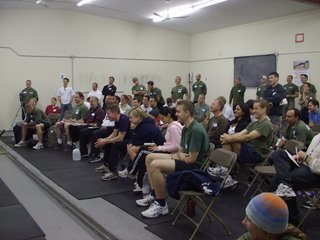
Back in our seats, Coach asked if anyone managed to keep up with Nicole. No hands. He worked his way down—“Nineteen squats? Eighteen?” One guy raised his hand. “Seventeen?” No one. “Sixteen? Fifteen?” Hands started to go up. Mine stayed down. I wasn’t sure what I’d scored, because it’s hard to count when you’re dying.
Coach took up his station at the whiteboard.
Crossfit is empirically driven. We do things because they work, and we find out they work by doing them. Exercise science informs Crossfit only tangentially—academic work is largely ignored in favor of trial and error conditioning. If a particular theory can be proved through real-world experience, it becomes practice.
If not, it remains theory.
The Internet has given Coach Glassman a fantastic tool for refining the Crossfit Method. Hundreds of comments regarding the Workout of the Day are posted daily, giving him insight into the quality of the program. By examining the output—the relative experience of the participants—Coach is able to tweak the input, changing the sequence and duration of the prescribed movements to optimize physical development. In this manner, Crossfit is community developed and continuously tested.
The Method comes with a simple caveat—if you can come up with something better, we’ll do it. To paraphrase Coach, if a three-day sequence of yoga, pilates, and the WOD creates world-class athletes, we’ll be doing yoga, pilates, and the WOD. Until then, we’ll stick with what we know—a carefully orchestrated combination of gymnastics, weightlifting, and sprinting.
The squat, press, and deadlift represent the foundations of human movement—Crossfit embraces this triad and expands its scope. Coach illustrated this expansion with a simple diagram.
The squat becomes the front squat as resistance is added to the movement. The front squat is more difficult than the air squat, requiring a higher level of strength, coordination, and power. The sequence culminates in the overhead squat, the most difficult of the three movements.
This three-part progression holds true for the press. The press becomes the push press becomes the push jerk. Each subsequent movement requires increased agility and coordination, enabling progressively larger loads to be pushed overhead.
The deadlift is extremely functional, enabling large loads to be raised to hip height. It evolves into the sumo deadlift high-pull, a movement that brings the load to the upper chest through a combination of hip extension and close-grip pulling. This sequence ends in the clean, an exercise that allows otherwise unmanageable objects to be pushed overhead.
Nicole demonstrated each of the second-tier movements. Coach stressed the importance of the rack position during the front squat and the need to remain completely vertical during the dip/drive portion of the push press. During the dip and drive, the midline moves in a vertical plane, straying neither forward nor backward.

The sumo deadlift high-pull has tremendous real-world application, as most objects don’t lend themselves to being picked up with a conventional deadlift. Boulders, sandbags, and other small loads must be picked up with a close grip rather than a wide grip, rendering the conventional deadlift useless.
As the movements progress along the continuum of difficulty, they require more and more power for successful execution. Coach would return to this point after lunch.
At Nicole’s cue, we broke into groups of six or seven athletes, each attended by a bevy of veteran trainers. The student-to-teacher ratio during these sessions was fantastic, approaching one-on-one. The feedback was quick and freely given. We reviewed the front squat, the push press, and the deadlift using five-foot lengths of PVC as resistance.
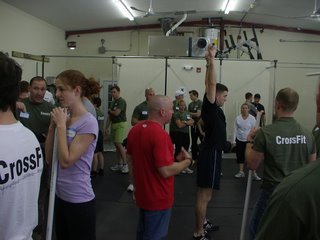
An eight-ounce pipe precludes a proper rack position for all but the most flexible athletes. I am not a flexible athlete. With a trainer pushing down on the pipe, I descended into the hole, only to realize my legs were totally frozen from the morning Tabata session. Once again my inadequate lumbar arch made an appearance, eliciting cries of “Arch!” from my new teachers.
I disappointed them horribly, cranking out Quasimodo-esque squats on command.
The push press wasn’t much better—I was slow with the dip and my chest was determined to pitch forward. After a mild correction, I was push pressing to everyone’s satisfaction.
We reviewed the sumo deadlift high-pull under the watchful eyes of Kelly Moore and Jesse Woody, cranking elbows toward the ceiling. I escaped unscathed, released into the October afternoon to find some lunch.
Sam, John, Heidi, Shad, and I crammed into Sammy’s beat-up Ford Focus and roared off toward Trader Joe’s. Several chicken breasts and some uber-crappy sandwiches later, we were back at the Facility, ready for more.

Our lesson in the Tao of Crossfit continued after the break. Unless you’ve been living under a rock, you’ve heard the phrase “constantly varied, functional movement, executed at high intensity” several hundred times. I’ve seen more word-for-word copying of this statement in the Crossfit-o-sphere than any other Glassman-ism, and for good reason.
It describes Crossfit perfectly.
Coach addressed functional movement first. The exercises employed by Crossfit exhibit “universal motor recruitment patterns”. This means they exist everywhere. They are not contrivances specific to the gym.
Coach flapped his arms like he was trying to take off, driving home his point by mimicking the absurdity of the weighted lateral raise. Functional movement is always applicable, in that it transfers easily to daily life. Real-world squatting, lifting, pulling, and pushing are all done in a non-isolated, compound manner, and we train for the real world. Therefore, Crossfit makes exclusive use of compound movements.
In Crossfit, intensity is exactly analogous to power; the latter defined as force multiplied by distance over time. Increased power output invariably leads to increased fitness, as seen again and again through observation of Crossfit athletes.
Power = (Force * Distance)/Time
Crossfit naturally incorporates the pursuit of increased power output. WODs are typically structured to elicit a specific number of reps in an unknown timeframe or an unknown number of reps in a specific timeframe.
For instance, “Fran” demands 45 repetitions each of the thruster and the pull-up. The duration of the effort is up to the athlete. In this case, the “force times distance” portion of the workout is fixed, leaving time as the unknown variable. The less time it takes the athlete to complete the workout, the more power he/she has generated.
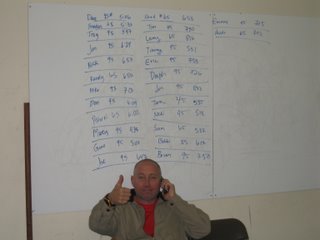
By way of contrast, “Cindy” holds time constant, demanding the athlete complete as many rounds as possible in twenty minutes of a pull-up/push-up/squat combination. To maximize power output, the athlete must increase the “force times distance” portion by completing more rounds.
In both cases, the fittest athlete is the one who produces the most power.
With a subtle warning, Coach Glassman theorized that greater power outputs lead to increased neuroendocrine response, creating changes in body composition that “mimic exogenous hormone therapy”. In other words, Crossfitters begin to take the shape of steroid users without the negative side effects—they enjoy low body fat levels and increased lean muscle mass through high power output.
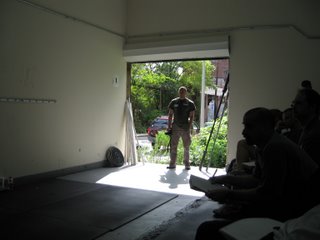
The impact of compound movement extends beyond mechanics. For instance, deadlifting will improve an athlete’s sprint speed even though the two movements are mechanically dissimilar. This cross-exercise improvement seems to be unique to compound movement, and serves as further evidence of the efficacy of the Crossfit Method.
The argument for constant variety in our training is simple. To tackle unforeseen tasks, we must confront and overcome the unknown on a regular basis. When faced with a novel physical task, “we fail at the margins of our experience or exposure.”
Toward eliminating failure, Crossfit emphasizes exposure to functional exercises across aerobic and anaerobic metabolic pathways. Coach offered the observation that endurance-sport athletes lose their superhuman endurance capacity even when asked to compete in outwardly similar events—marathoners are typically poor cyclists, exhibiting the same lack of cardio-respiratory endurance as novice cyclists. In his words, “VO2 max doesn’t translate very well.”
At the other end of the spectrum, “Crossfit produces a ready state.” Coach presented the example of Greg Admundson, a crazy-fit product of his Santa Cruz gym. While waiting to compete in the “Toughest Cop Alive” Competition, Greg participated in a triathlon, taking second place despite no sport-specific training. He won the TCA Competition later in the week, beating out better-rested athletes for the title.

According to Coach, adequate variance, functionality, and intensity are sufficient for calling any activity Crossfit: “If you were to dig a moat, fill it with crocodiles, swim the moat, scale a castle wall, battle a dragon, throw the damsel over your shoulder and escape, that would be Crossfit!”
Our survey course in Crossfit philosophy over for the day, we turned our attention to the final three movements in the progression—the overhead squat, the push jerk, and the clean. Nicole took center stage to demonstrate each exercise.
The overhead squat possesses all the mechanical attributes the squat, putting the load 8-12 inches overhead.
Using a dowel, Nicole performed dislocates to find her optimal overhead squat grip. She does this by cycling the bar from the hang to overhead to behind the back without bending her arms. The wider the grip, the easier the movement becomes. The athlete works her hands inward on successive repetitions until she cannot complete the movement without bending the arms. Her optimal grip is immediately outside this terminal position.
Grip width determines clearance of the bar over the head. The shoulders are active, shrugged hard. This tension is critical to performing a successful overhead squat with any significant load.

The overhead squat amplifies dynamic and structural problems in the squat. By necessity, any forward inclination of the torso places the load behind the neck, putting the athlete in a suboptimal position to complete the squat. She must cantilever severely to keep the load in the frontal plane. When the torso is kept upright, the movement becomes much easier—the load is directly over the heels, enabling the athlete to transfer force from the ground directly to the bar.

The push jerk is the granddaddy of all presses. Once the push jerk is mastered, the earlier iterations of the press become obsolete—it will get more weight overhead than the press or the push press, respectively.
The standing press is simple, cued with one word: “Press.” The push press is more complicated: “Dip, Drive, and Press.” The push jerk begins where the push press ends, incorporating an additional dip and catch: “Dip, Drive, Press, Dip, and Stand.”
The athlete puts momentum and elevation on the bar, throwing herself underneath it in a partial squat, arms extended overhead. The final movement is very similar to the third pull of the clean or the snatch. The arms lockout overhead milliseconds before the feet hit the ground—“Jump and land partially squatted.”
Nicole performed the push jerk with extraordinary speed, demonstrating an exceptional ability to leverage herself under the bar in perfect position. Shoulder flexibility plays a huge role in the successful push jerk, as the bar ends up overhead with the hands just outside shoulder width. Nicole nailed the movement again and again, her flexibility evident.
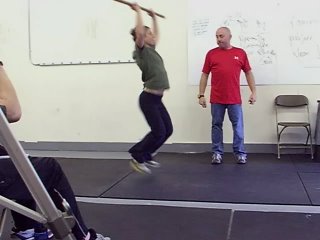
According to Coach, each new press variation should allow for a 30-50% increase in load over the previous press. The push jerk momentarily puts the athlete in freefall with the load locked overhead—the weight is limited only by the structural integrity of the body on impact. Coach offered the example of being thrown out of an airplane with a grand piano. You’d be able to press it overhead without any difficulty, but the landing would suck.
The final exercise for the day was the clean. Nicole held a Dynamax ball in a close-grip deadlift, standing and shrugging on Coach’s cue. She went to triple extension, rendering the ball momentarily weightless.
“A clean is exactly playing catch with yourself with a heavy object.”
Coach emphasized this aspect of the clean, commanding us to watch the ball rather than Nicole. As she shrugged, the ball hovered just long enough for her to get underneath it in a solid squat.



The clean has a large psychological component—it is not human nature to want to throw oneself beneath an object in freefall.
“The athleticism of (the clean) is not in the pull…powerlifters look at the loads Olympic lifted, and they’re not impressed…There’s one guy that can get under that 650 pounds, but probably thousands that can pull the load as high as he did,” Coach said, gesturing toward his abdomen.
The glory of the clean is the third pull.
We broke into our groups for individual work on the overhead squat, the push jerk, and the clean. During this session, I had a wonderful revelation regarding my inability to push jerk properly. My failing is caused by inflexibility.
While training at Crossfit Boston, I am repeatedly called out for landing stiff-legged. Unfortunately, this is the only way I am able to land and still maintain an upright torso, as my shoulder and hamstring flexibility levels prevent a proper squat with my hands directly overhead.
Of all the things I learned at the Seminar, this was the most valuable. Knowing the source of your failings is a huge boon to self-improvement.
We reconvened around the whiteboard for a final lecture. Coach encouraged us to maintain a proper attitude toward the highest order of athletic movements, as they can take a lifetime to master.
He also encouraged us to focus on mechanics, properly executing the basic movements before moving on to more advanced exercises—“You can’t go to reading if you don’t know the alphabet.”
He warned us to respect sub-maximal loads. In his experience, most injuries occur at 60-70% 1RM. These weights produce enough force to hurt you, but aren’t large enough to engender proper respect. Focus is paramount when working in this load range. Proper technique protects athletes from injury, even when post-maximal loads are used. If correct positioning is employed, a failed lift won’t end in a hospital visit.
We cleared the floor, and the trainers brought out barbells and stacks of 25-pound bumper plates. They set up nine stations, each with a Dynamax ball and a 95-pound bar.
It was time for Fran.
Greg Amundson and Kelly Moore each took at spot directly in front of the pull-up bars, giving an up-close demonstration of peak Crossfit performance. I’ve never been so amped in my life. Greg’s sub-3:00 attempts at Fran are the stuff of legend, and I was ecstatic to have the chance to witness it firsthand.

With an entire room of screaming athletes behind them, Greg and Kelly blasted through the workout. Sets of thrusters and pull-ups melted into each other as they cranked onward, Greg finishing in 3:09 with Kelly 30 seconds behind. It was amazing--see it here.
When Coach called for athletes to take the floor, I bolted for the stations closest to the pull-up bar. Dead center, with Jesse Woody standing to my right, we launched into Fran. Surrounded by veteran Crossfitters, I felt like I was exercising underwater. I deliberately broke up my first set of thrusters into sevens, preserving some energy for the final assault.
The pull-up bar was an absolute melee, athletes jostling for room to kip. I made the mistake of going inside the bar, losing my slot when I dropped off for a rest. Frustrated, I stood in a forest of kipping legs, waiting. Ten seconds later, I was free.

The mid-workout haze set-in as I went through the remaining thrusters and pull-ups. Jesse counted my reps, preventing my super-ball of a barbell from killing bystanders during the transitions. Surrounded by friends screaming my name, I felt like I had the power of a thousand men.
After the last pull-up, I called for time. Six minutes, 29 seconds, a full fifty-five seconds better than my previous personal record. My enthusiasm was tempered by the knowledge that Greg had halved my time, but a new PR was always welcome.
Two more waves of athletes went through the workout, driven by the incessant yelling of the Level II trainers. For the third wave the bars were set at 65 pounds, and the women ripped through Fran.

Sam dominated the heat, finishing the workout in 5:37 as prescribed. She kipped out every pull-up, drawing the attention of Kelly, Lynne, and Nicole. When it was all over, Sam claimed her place as an upcoming Crossfit superstar, Kelly joking that she had better start training harder.

In the span of one day, I’d seen the heart of Crossfit and received enough motivation to last a lifetime. After a brief discussion on the merits of large-bore shotguns, our crew piled into the Ford for the short trip back to Brookline, headed for dinner and some much need rest.
We passed the evening in my living room, trading theories on proper training methods, periodization, and the best way to handle unmotivated athletes. I fell asleep at 9:00, a hundred thousand theories bouncing around in my head.
I had a million questions. Luckily, my backstage pass was good for one more day.
Fran Video courtesy of John Velandra. Stay tuned for Day Two. All the excitement of Day One with none of the funny aftertaste!

“We teach people what their ass does for a living.”—Greg Glassman
Walking into the first day of a Crossfit Certification is like walking onto a Hollywood set. You recognize everyone, and no one recognizes you.
The hallucinogenic qualities of the experience are heightened by the familiarity of the terrain. This is the building I train in every day. At least, I think it’s this building.
The equipment had disappeared, and a bunch of Crossfit Rockstars stood in its place. Greg Amundson, Nicole Carroll, Coach. Kelly Moore, Jesse Woody, Lynne Pitts, and Carrie Klumpar.
I felt like a pre-teen girl at an N’Sync concert, except the stage-front security was nowhere to be seen. Disneyland for fitness freaks. A backstage pass to GPP Lollapalooza.
It was on.
Sam and I were ridiculously early, towing our new friends from Crossfit Cape Fear—John, Shad, and Heidi. We signed the “Yep, you’re probably going to die” waiver, and proceeded to hug everyone in the building. I zeroed in on Lynne. I’d failed to convince her that the gangsters in Roxbury are asleep at 7:00 a.m., and I was anxious to hear the horror stories of her journey from New Hampshire.
She didn’t have any, but she did have a new piece of equipment coming her way. I grabbed an AF Bar from the corner, and presented it with all the decorum of a guard at Westminster Abbey. It had the intended effect—jealousy. I think Kelly wanted one before she found out what it was.

Standing with two Crossfit legends, I bellowed across the room at my girlfriend, gesturing for her to come say hello. Sammy came over, smiling like it was going out of style.
Between the two of them, Lynne and Kelly beat the hell out of nearly every fitness pursuit worth pursuing—Crossfit, RKC, Clubbells, powerlifting, gymnastics—and Sam knows it. Standing face-to-face with her role models, Sam exhibited all the humility and grace you’d expect from a novice. Not surprisingly, those traits were returned in spades by our new friends. The lack of ego was palpable.
The joy on Sam’s face was worth the price of admission, and we hadn’t even started yet. At 8:00, Nicole stood under the whiteboard, calling for attention.
She introduced Coach Glassman to thunderous applause. Greg Glassman created Crossfit during decades of work as a trainer, embracing a contrarian approach to fitness that often left him on the wrong side of the popularity divide. He commands attention in a manner that belies his stature—at five foot six or so, his physical presence is unintimidating. Nonetheless, his eloquence draws you in and keeps you there.
We started at the beginning. The Tao of Crossfit. In tiny blue letters, Coach marked up the corner of the board:
“Empirically Driven Continuously Tested Community Developed Constantly Varied Functional Movement High Intensity.”

Everything you need to know about Crossfit in twelve words. He left his scribble to soak in, and launched into the basic movements of our trade.
The squat. According to Coach, it takes three to five years to develop a mature squat—torso upright, lumbar arch maintained, midline stabilization constant.
Using his demonstration piece, a sarcastically self-professed “dumb jock”, we got an up-close view of athletic perfection. Nicole made the squat look easy, cranking out rep after rep with flawless form. The downward portion of the movement is initiated by the hip flexors—rather than fall into the bottom position, the athlete pulls back and down. The return to standing is accomplished using a full contraction of the butt and hamstrings, and the weight remains on the heels for the duration. Her lower lumbar arch is enduring.

It’s amazing how hard this is to do correctly.
Coach pointed out the alignment of the pelvis and spine, using a simplified schematic that we’d see ad nauseum over the next two days—a stylized “s” connected at the tail with an oval. For a first-hand look at this artistic masterpiece and a great overview of basic anatomy and physiology, grab a copy of the August 2003 Crossfit Journal.
The point of the drawing: in nearly every athletic movement, the pelvis remains wedded to the spine, forming a continuous line unperturbed by posterior tilt.
“In this position, she’s bombproof. She’s bulletproof…your ability to punch, jump, run, throw…will be largely determined by your ability to maintain stabilization of this structure…Extension of the hip is necessary and maybe even sufficient for elite athleticism. If you cannot powerfully, explosively extend the hip while maintaining midline stabilization, you are working at a fraction of your capacity.”

This little bit of information would remain with me all weekend long, rearing its head again and again as I practiced squats, wall ball, high pulls, and slam ball. Evidently, my spinal alignment leaves something to be desired.
Using a five-foot dowel, Nicole demonstrated proper deadlifting technique. The shoulders remain behind the hands, arms taut, lumbar arch maintained. The load stays in the frontal plane throughout the movement, following a vertical path from the ground to lockout.
To allow for a straight up and down movement, the knees clear out of the way of the bar—the bar does not travel around the knees! Nicole went through the deadlift at warp-speed, the return to the ground precisely retracing the path to lockout. She probably could’ve pulled 225 with the same grace, although her speed might have suffered.
Our lesson in foundational movements continued with a review of the shoulder press. Coach stressed the importance of shoulder flexibility in facilitating overhead lockout. During the shoulder press, the entire body is active, leaving nothing relaxed. The shoulders are pressed into the ears, stabilized by the traps, and the bar is directly overhead. Everything should be tight and working.
Shoulder flexibility can be developed thorough focused stretching—hanging from the pullup bar with a narrow grip or partner stretching Superman-style.
We’d been sitting for close to two hours without any form of physical activity, and the fine folks running the Cert decided to change that with a vigorous bout of bottom-to-bottom Tabata squats.
Gee, thanks.
The Tabata protocol dictates twenty seconds of work followed by ten seconds of rest, repeated for eight intervals. A bottom-to-bottom squat is just like it sounds—you start and end in the hole. Conveniently, the “rest” also takes place at this lower elevation.
Like everything else Crossfit, the Tabata interval is scored. The lowest number of squats completed during any of the eight intervals is your number. This has ramifications on the athlete’s strategy during the exercise.
“What does it tell me if you do twelve in one interval and sixteen in the next?”
Coach answered his own question: “You’re stupid.”
With a quick warm-up (standing up and putting away the chairs), we formed a circle around the room. Coach stood in the center, and showed us three ways to cheat the bottom-to-bottom: inadequate depth, slumping in the bottom position, and inadequate extension. Then he put Nicole in there.
“Just keep up with her.”
This is like trying to outrun a thoroughbred on the back stretch of the Belmont Stakes. Nicole is capable of upwards of 20 squats in a single interval. I am not. With Dave Picardy and Jesse Woody standing directly over my left shoulder, we proceeded to Tabata-ize our morning. With typical indiscretion, I tried to keep up with Nicole. While Sammy received effusive praise to my right, I heard over and over:
“Come up higher. You’re losing your arch. Lost it. Don’t sink. Arch!” Yep, okay guys. I’m on it. I couldn’t have pushed myself higher in the bottom position if Jesse had broken out a pistol and threatened to aerate my head.
The Tabata protocol has the unique distinction of causing aerobic and anaerobic failure simultaneously, placing it in the same torturous class as electro-shock therapy at Guantanamo Bay. By the end of the protocol, my legs were a curious mix of Jello and cement, and my beige folding chair looked like an overstuffed couch.

Back in our seats, Coach asked if anyone managed to keep up with Nicole. No hands. He worked his way down—“Nineteen squats? Eighteen?” One guy raised his hand. “Seventeen?” No one. “Sixteen? Fifteen?” Hands started to go up. Mine stayed down. I wasn’t sure what I’d scored, because it’s hard to count when you’re dying.
Coach took up his station at the whiteboard.
Crossfit is empirically driven. We do things because they work, and we find out they work by doing them. Exercise science informs Crossfit only tangentially—academic work is largely ignored in favor of trial and error conditioning. If a particular theory can be proved through real-world experience, it becomes practice.
If not, it remains theory.
The Internet has given Coach Glassman a fantastic tool for refining the Crossfit Method. Hundreds of comments regarding the Workout of the Day are posted daily, giving him insight into the quality of the program. By examining the output—the relative experience of the participants—Coach is able to tweak the input, changing the sequence and duration of the prescribed movements to optimize physical development. In this manner, Crossfit is community developed and continuously tested.
The Method comes with a simple caveat—if you can come up with something better, we’ll do it. To paraphrase Coach, if a three-day sequence of yoga, pilates, and the WOD creates world-class athletes, we’ll be doing yoga, pilates, and the WOD. Until then, we’ll stick with what we know—a carefully orchestrated combination of gymnastics, weightlifting, and sprinting.
The squat, press, and deadlift represent the foundations of human movement—Crossfit embraces this triad and expands its scope. Coach illustrated this expansion with a simple diagram.
The squat becomes the front squat as resistance is added to the movement. The front squat is more difficult than the air squat, requiring a higher level of strength, coordination, and power. The sequence culminates in the overhead squat, the most difficult of the three movements.
This three-part progression holds true for the press. The press becomes the push press becomes the push jerk. Each subsequent movement requires increased agility and coordination, enabling progressively larger loads to be pushed overhead.
The deadlift is extremely functional, enabling large loads to be raised to hip height. It evolves into the sumo deadlift high-pull, a movement that brings the load to the upper chest through a combination of hip extension and close-grip pulling. This sequence ends in the clean, an exercise that allows otherwise unmanageable objects to be pushed overhead.
Nicole demonstrated each of the second-tier movements. Coach stressed the importance of the rack position during the front squat and the need to remain completely vertical during the dip/drive portion of the push press. During the dip and drive, the midline moves in a vertical plane, straying neither forward nor backward.

The sumo deadlift high-pull has tremendous real-world application, as most objects don’t lend themselves to being picked up with a conventional deadlift. Boulders, sandbags, and other small loads must be picked up with a close grip rather than a wide grip, rendering the conventional deadlift useless.
As the movements progress along the continuum of difficulty, they require more and more power for successful execution. Coach would return to this point after lunch.
At Nicole’s cue, we broke into groups of six or seven athletes, each attended by a bevy of veteran trainers. The student-to-teacher ratio during these sessions was fantastic, approaching one-on-one. The feedback was quick and freely given. We reviewed the front squat, the push press, and the deadlift using five-foot lengths of PVC as resistance.

An eight-ounce pipe precludes a proper rack position for all but the most flexible athletes. I am not a flexible athlete. With a trainer pushing down on the pipe, I descended into the hole, only to realize my legs were totally frozen from the morning Tabata session. Once again my inadequate lumbar arch made an appearance, eliciting cries of “Arch!” from my new teachers.
I disappointed them horribly, cranking out Quasimodo-esque squats on command.
The push press wasn’t much better—I was slow with the dip and my chest was determined to pitch forward. After a mild correction, I was push pressing to everyone’s satisfaction.
We reviewed the sumo deadlift high-pull under the watchful eyes of Kelly Moore and Jesse Woody, cranking elbows toward the ceiling. I escaped unscathed, released into the October afternoon to find some lunch.
Sam, John, Heidi, Shad, and I crammed into Sammy’s beat-up Ford Focus and roared off toward Trader Joe’s. Several chicken breasts and some uber-crappy sandwiches later, we were back at the Facility, ready for more.

Our lesson in the Tao of Crossfit continued after the break. Unless you’ve been living under a rock, you’ve heard the phrase “constantly varied, functional movement, executed at high intensity” several hundred times. I’ve seen more word-for-word copying of this statement in the Crossfit-o-sphere than any other Glassman-ism, and for good reason.
It describes Crossfit perfectly.
Coach addressed functional movement first. The exercises employed by Crossfit exhibit “universal motor recruitment patterns”. This means they exist everywhere. They are not contrivances specific to the gym.
Coach flapped his arms like he was trying to take off, driving home his point by mimicking the absurdity of the weighted lateral raise. Functional movement is always applicable, in that it transfers easily to daily life. Real-world squatting, lifting, pulling, and pushing are all done in a non-isolated, compound manner, and we train for the real world. Therefore, Crossfit makes exclusive use of compound movements.
In Crossfit, intensity is exactly analogous to power; the latter defined as force multiplied by distance over time. Increased power output invariably leads to increased fitness, as seen again and again through observation of Crossfit athletes.
Power = (Force * Distance)/Time
Crossfit naturally incorporates the pursuit of increased power output. WODs are typically structured to elicit a specific number of reps in an unknown timeframe or an unknown number of reps in a specific timeframe.
For instance, “Fran” demands 45 repetitions each of the thruster and the pull-up. The duration of the effort is up to the athlete. In this case, the “force times distance” portion of the workout is fixed, leaving time as the unknown variable. The less time it takes the athlete to complete the workout, the more power he/she has generated.

By way of contrast, “Cindy” holds time constant, demanding the athlete complete as many rounds as possible in twenty minutes of a pull-up/push-up/squat combination. To maximize power output, the athlete must increase the “force times distance” portion by completing more rounds.
In both cases, the fittest athlete is the one who produces the most power.
With a subtle warning, Coach Glassman theorized that greater power outputs lead to increased neuroendocrine response, creating changes in body composition that “mimic exogenous hormone therapy”. In other words, Crossfitters begin to take the shape of steroid users without the negative side effects—they enjoy low body fat levels and increased lean muscle mass through high power output.

The impact of compound movement extends beyond mechanics. For instance, deadlifting will improve an athlete’s sprint speed even though the two movements are mechanically dissimilar. This cross-exercise improvement seems to be unique to compound movement, and serves as further evidence of the efficacy of the Crossfit Method.
The argument for constant variety in our training is simple. To tackle unforeseen tasks, we must confront and overcome the unknown on a regular basis. When faced with a novel physical task, “we fail at the margins of our experience or exposure.”
Toward eliminating failure, Crossfit emphasizes exposure to functional exercises across aerobic and anaerobic metabolic pathways. Coach offered the observation that endurance-sport athletes lose their superhuman endurance capacity even when asked to compete in outwardly similar events—marathoners are typically poor cyclists, exhibiting the same lack of cardio-respiratory endurance as novice cyclists. In his words, “VO2 max doesn’t translate very well.”
At the other end of the spectrum, “Crossfit produces a ready state.” Coach presented the example of Greg Admundson, a crazy-fit product of his Santa Cruz gym. While waiting to compete in the “Toughest Cop Alive” Competition, Greg participated in a triathlon, taking second place despite no sport-specific training. He won the TCA Competition later in the week, beating out better-rested athletes for the title.

According to Coach, adequate variance, functionality, and intensity are sufficient for calling any activity Crossfit: “If you were to dig a moat, fill it with crocodiles, swim the moat, scale a castle wall, battle a dragon, throw the damsel over your shoulder and escape, that would be Crossfit!”
Our survey course in Crossfit philosophy over for the day, we turned our attention to the final three movements in the progression—the overhead squat, the push jerk, and the clean. Nicole took center stage to demonstrate each exercise.
The overhead squat possesses all the mechanical attributes the squat, putting the load 8-12 inches overhead.
Using a dowel, Nicole performed dislocates to find her optimal overhead squat grip. She does this by cycling the bar from the hang to overhead to behind the back without bending her arms. The wider the grip, the easier the movement becomes. The athlete works her hands inward on successive repetitions until she cannot complete the movement without bending the arms. Her optimal grip is immediately outside this terminal position.
Grip width determines clearance of the bar over the head. The shoulders are active, shrugged hard. This tension is critical to performing a successful overhead squat with any significant load.

The overhead squat amplifies dynamic and structural problems in the squat. By necessity, any forward inclination of the torso places the load behind the neck, putting the athlete in a suboptimal position to complete the squat. She must cantilever severely to keep the load in the frontal plane. When the torso is kept upright, the movement becomes much easier—the load is directly over the heels, enabling the athlete to transfer force from the ground directly to the bar.

The push jerk is the granddaddy of all presses. Once the push jerk is mastered, the earlier iterations of the press become obsolete—it will get more weight overhead than the press or the push press, respectively.
The standing press is simple, cued with one word: “Press.” The push press is more complicated: “Dip, Drive, and Press.” The push jerk begins where the push press ends, incorporating an additional dip and catch: “Dip, Drive, Press, Dip, and Stand.”
The athlete puts momentum and elevation on the bar, throwing herself underneath it in a partial squat, arms extended overhead. The final movement is very similar to the third pull of the clean or the snatch. The arms lockout overhead milliseconds before the feet hit the ground—“Jump and land partially squatted.”
Nicole performed the push jerk with extraordinary speed, demonstrating an exceptional ability to leverage herself under the bar in perfect position. Shoulder flexibility plays a huge role in the successful push jerk, as the bar ends up overhead with the hands just outside shoulder width. Nicole nailed the movement again and again, her flexibility evident.

According to Coach, each new press variation should allow for a 30-50% increase in load over the previous press. The push jerk momentarily puts the athlete in freefall with the load locked overhead—the weight is limited only by the structural integrity of the body on impact. Coach offered the example of being thrown out of an airplane with a grand piano. You’d be able to press it overhead without any difficulty, but the landing would suck.
The final exercise for the day was the clean. Nicole held a Dynamax ball in a close-grip deadlift, standing and shrugging on Coach’s cue. She went to triple extension, rendering the ball momentarily weightless.
“A clean is exactly playing catch with yourself with a heavy object.”
Coach emphasized this aspect of the clean, commanding us to watch the ball rather than Nicole. As she shrugged, the ball hovered just long enough for her to get underneath it in a solid squat.



The clean has a large psychological component—it is not human nature to want to throw oneself beneath an object in freefall.
“The athleticism of (the clean) is not in the pull…powerlifters look at the loads Olympic lifted, and they’re not impressed…There’s one guy that can get under that 650 pounds, but probably thousands that can pull the load as high as he did,” Coach said, gesturing toward his abdomen.
The glory of the clean is the third pull.
We broke into our groups for individual work on the overhead squat, the push jerk, and the clean. During this session, I had a wonderful revelation regarding my inability to push jerk properly. My failing is caused by inflexibility.
While training at Crossfit Boston, I am repeatedly called out for landing stiff-legged. Unfortunately, this is the only way I am able to land and still maintain an upright torso, as my shoulder and hamstring flexibility levels prevent a proper squat with my hands directly overhead.
Of all the things I learned at the Seminar, this was the most valuable. Knowing the source of your failings is a huge boon to self-improvement.
We reconvened around the whiteboard for a final lecture. Coach encouraged us to maintain a proper attitude toward the highest order of athletic movements, as they can take a lifetime to master.
He also encouraged us to focus on mechanics, properly executing the basic movements before moving on to more advanced exercises—“You can’t go to reading if you don’t know the alphabet.”
He warned us to respect sub-maximal loads. In his experience, most injuries occur at 60-70% 1RM. These weights produce enough force to hurt you, but aren’t large enough to engender proper respect. Focus is paramount when working in this load range. Proper technique protects athletes from injury, even when post-maximal loads are used. If correct positioning is employed, a failed lift won’t end in a hospital visit.
We cleared the floor, and the trainers brought out barbells and stacks of 25-pound bumper plates. They set up nine stations, each with a Dynamax ball and a 95-pound bar.
It was time for Fran.
Greg Amundson and Kelly Moore each took at spot directly in front of the pull-up bars, giving an up-close demonstration of peak Crossfit performance. I’ve never been so amped in my life. Greg’s sub-3:00 attempts at Fran are the stuff of legend, and I was ecstatic to have the chance to witness it firsthand.

With an entire room of screaming athletes behind them, Greg and Kelly blasted through the workout. Sets of thrusters and pull-ups melted into each other as they cranked onward, Greg finishing in 3:09 with Kelly 30 seconds behind. It was amazing--see it here.
When Coach called for athletes to take the floor, I bolted for the stations closest to the pull-up bar. Dead center, with Jesse Woody standing to my right, we launched into Fran. Surrounded by veteran Crossfitters, I felt like I was exercising underwater. I deliberately broke up my first set of thrusters into sevens, preserving some energy for the final assault.
The pull-up bar was an absolute melee, athletes jostling for room to kip. I made the mistake of going inside the bar, losing my slot when I dropped off for a rest. Frustrated, I stood in a forest of kipping legs, waiting. Ten seconds later, I was free.

The mid-workout haze set-in as I went through the remaining thrusters and pull-ups. Jesse counted my reps, preventing my super-ball of a barbell from killing bystanders during the transitions. Surrounded by friends screaming my name, I felt like I had the power of a thousand men.
After the last pull-up, I called for time. Six minutes, 29 seconds, a full fifty-five seconds better than my previous personal record. My enthusiasm was tempered by the knowledge that Greg had halved my time, but a new PR was always welcome.
Two more waves of athletes went through the workout, driven by the incessant yelling of the Level II trainers. For the third wave the bars were set at 65 pounds, and the women ripped through Fran.

Sam dominated the heat, finishing the workout in 5:37 as prescribed. She kipped out every pull-up, drawing the attention of Kelly, Lynne, and Nicole. When it was all over, Sam claimed her place as an upcoming Crossfit superstar, Kelly joking that she had better start training harder.

In the span of one day, I’d seen the heart of Crossfit and received enough motivation to last a lifetime. After a brief discussion on the merits of large-bore shotguns, our crew piled into the Ford for the short trip back to Brookline, headed for dinner and some much need rest.
We passed the evening in my living room, trading theories on proper training methods, periodization, and the best way to handle unmotivated athletes. I fell asleep at 9:00, a hundred thousand theories bouncing around in my head.
I had a million questions. Luckily, my backstage pass was good for one more day.
Fran Video courtesy of John Velandra. Stay tuned for Day Two. All the excitement of Day One with none of the funny aftertaste!
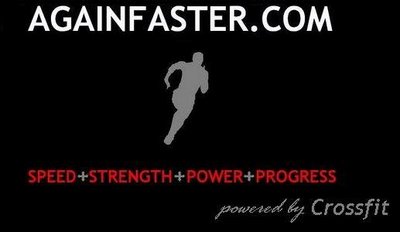





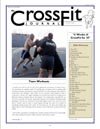








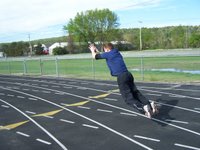




0 Comments:
Post a Comment
<< Home